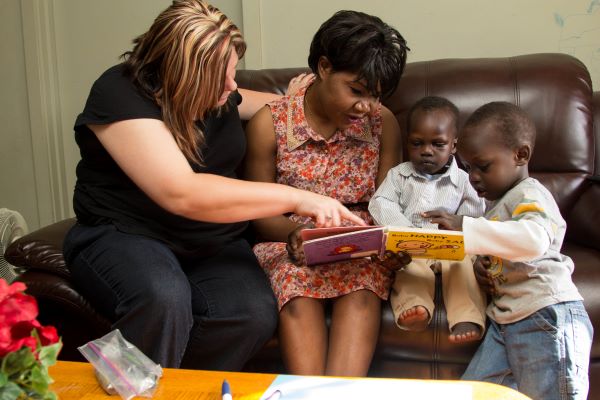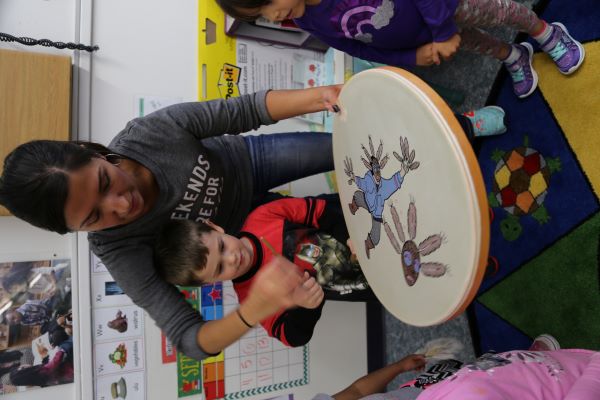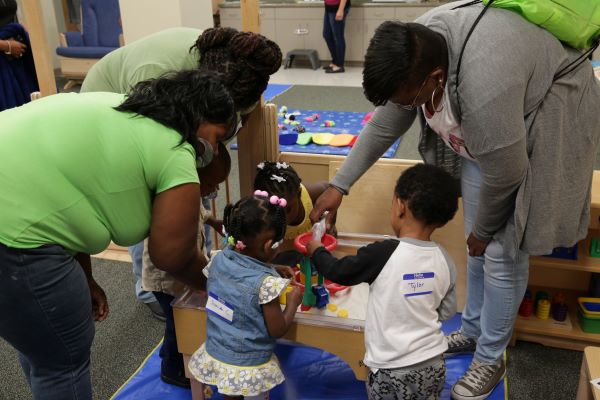Culturally sustaining programming is shaped primarily by the communities, staff, and families of each Head Start program.
Why It Matters
 To guarantee that all children, families, and staff reach their fullest potential, an equity-focused mindset is key. Equity-focused program practices are built on positive and nurturing relationships and interactions that are culturally and linguistically responsive, bias conscious, and affirm all aspects of identity (e.g., race, ethnicity, culture, language, disability, gender, socioeconomic status, etc.). Children and families bring a wealth of knowledge, skills, and strengths rooted in cultural ways of knowing and being. Despite these strengths, research shows that Black, Latino, Indigenous, Asian, and other children of color, as well as children with disabilities, and their families, are more likely to have unfair and negative experiences in early learning settings, which can affect their developmental and academic outcomes. Programs must find ways to remedy these inequities through systems, services, policies, and practices that recognize and incorporate the cultural strengths of children, families, and staff.
To guarantee that all children, families, and staff reach their fullest potential, an equity-focused mindset is key. Equity-focused program practices are built on positive and nurturing relationships and interactions that are culturally and linguistically responsive, bias conscious, and affirm all aspects of identity (e.g., race, ethnicity, culture, language, disability, gender, socioeconomic status, etc.). Children and families bring a wealth of knowledge, skills, and strengths rooted in cultural ways of knowing and being. Despite these strengths, research shows that Black, Latino, Indigenous, Asian, and other children of color, as well as children with disabilities, and their families, are more likely to have unfair and negative experiences in early learning settings, which can affect their developmental and academic outcomes. Programs must find ways to remedy these inequities through systems, services, policies, and practices that recognize and incorporate the cultural strengths of children, families, and staff.
Connections to the HSPPS
In this section, learn about example indicators for this Multicultural Principle and how they are supported by the Head Start Program Performance Standards (HSPPS). Think about your program and your learning setting. Then, consider ways you already do these practices and ways you can more closely align to improve your practice.
| Example Indicators | Connections to the HSPPS |
|---|---|
| Staff work with families to find ways to communicate and participate that are comfortable and accessible. | Collaboration and communication with parents, 45 CFR §1302.41(a) |
| Staff promote a sense of belonging by integrating home languages and cultures into program practices. | Policy council and policy committee, 45 CFR §1301.3(b)(1) Determining community strengths, needs, and resources, 45 CFR §1302.11(b) Education and Child Development Services, 45 CFR §1302 Subpart C Parent engagement in education and child development services, 45 CFR §1302.34(b) Tribal language preservation and revitalization, 45 CFR §1302.36 |
| Staff help parents and families form connections with peers, mentors, and other community members in formal or informal social networks. | Family engagement, 45 CFR §1302.50 |
Example Indicators and Practical Strategies
Review practical strategies drawn from research and Head Start programs that promote a programs capacity to reflect and affirm the cultures of the children and families it serves.
Download the Try It! worksheet and choose one practice to focus on for one month. Use the prompts to thoughtfully plan how you will use the practice. The worksheet also includes tips for reflection after using the practice for one month.
Staff work with families to find ways to communicate and participate that are comfortable and accessible.
- Staff engage in two-way communication with families to learn about family and community values, language, and expectations.
- Staff take steps to overcome communication barriers to demonstrate a commitment to learning from and engaging all families.
- Use qualified and trained translators and interpreters as needed.
- Provide professional development opportunities for staff, so they learn skills to build strengths-based goal-oriented partnerships with families.
- Staff get to know each family before their child begins the program.
- Families raise their children in the context of culture. They use their knowledge of children’s development and caregiving — learned from their experiences and cultural communities — to make decisions about how they will raise their children.
- Train staff to use enrollment visits to gather information from the family about the child’s interests, strengths, and preferred ways to learn.
- Ask families about the ways the child learns in the home and about daily routines the child participates in.
- Invite the family to participate in learning activities by asking for their ideas and about their interest in volunteering in the program.
- Offer opportunities for the child and family to visit the program before the child starts.
Practice Example: Teaching teams from an Early Head Start program meet with each family before their child begins preschool, to conduct a family interview. During the interview, teams encourage parents and families to talk about important aspects of their culture, such as food, songs, and stories from their own languages. This way, staff get to know the child through the family’s home and background. Also, staff can use this information to enrich the classroom environment.
 Staff promote a sense of belonging by integrating home languages and cultures into program practices.
Staff promote a sense of belonging by integrating home languages and cultures into program practices.
- Staff use key words and phrases in the home languages of children during transitions and routines.
- Staff understand how children live and develop in a cultural sense and the relationship between culture and language. Language is one of the many ways through which culture affects child development. It shapes how people think and reason. Culture is fundamental in developing children’s personalities and how they express their identities.
- If staff don’t speak children’s home languages, encourage learning 10–20 “survival words” in each child’s language using the Ready DLL mobile app.
- Invite families, or others who speak the children’s home languages, into the learning space to use their languages.
- Bring language and literacy activities children know from home into group care and socialization activities.
- Include the traditions, values, and practices of children’s families when choosing themes to explore.
- Staff understand how children live and develop in a cultural sense and the relationship between culture and language. Language is one of the many ways through which culture affects child development. It shapes how people think and reason. Culture is fundamental in developing children’s personalities and how they express their identities.
- Staff design environments that support a sense of belonging by using objects, images, and print that honor children’s cultural, language, and individual identities.
- By learning about children’s families and communities, staff can reflect a child’s background, knowledge, and experience. This can be done in learning environments, materials, activities, and other practices. Having familiar items from home, or familiar images from the community, provides comfort for children and encourages exploration and learning.
- Use environmental print (labels, signs, posters) in the children’s home languages and in English.
- Use photographs, pictures, graphics, and other visuals to support English labels and signs.
- Bring materials from the children’s home cultures into the learning environment.
- Encourage staff to represent their culture in the learning environment.
Practice Example: A Migrant and Seasonal Head Start program puts up photos of each child’s family, taken during enrollment visits, on family trees displayed in the learning space. Classroom labels and posters are written in Spanish and English. The block area includes blocks covered with photos of familiar signs and buildings, such as the local library, stores, and markets.
Staff help parents and families form connections with peers, mentors, and other community members in formal or informal social networks.
- Encourage diverse families to participate in governing opportunities, including Policy Council, to help the program create culturally sustaining practices and policies.
- Plan opportunities for families to talk about their cultures, connect with others, and get acquainted during planned activities and less formal drop-in experiences. For example, plan cultural celebrations, or informally offer a space for families to gather for a cup of coffee, tea, or water after morning drop-off.
Voices from the Head Start Community
 In this section, a disabilities service coordinator from a community action agency (CAA) program discusses ways staff engage with families to provide services that reflect family preferences and multiple ways to participate.
In this section, a disabilities service coordinator from a community action agency (CAA) program discusses ways staff engage with families to provide services that reflect family preferences and multiple ways to participate.
Build relationships early.
Relationships start with the first interaction, during the first phone call seeking enrollment information. A family engagement specialist shared:
“It is easier to build those relationships up front and then, when you have to have harder conversations later on, families are more willing because they know we know them, they know us, they’re comfortable talking to us about the issues that they are seeing.”
Plan family-led activities.
The Head Start program hosts family socializing events, including family fun nights and family-facilitated workshops. The program asks families to complete a “helping hands” survey that focuses on their culture and experiences. With this information, staff may ask families if they’re willing to share their expertise with children in the classroom. Examples include cooking activities, sharing a story from childhood, reading a book that’s special to the family, and sharing something unique to the family’s culture. The workshops give parents an opportunity to share skills and learn from one another, rather than only from program staff.
Include multiple ways families can participate.
A Head Start program in Indiana tries to offer two events a month in each of the counties they serve. For families who are unable to contribute in-person during class time, the program offers other ways they can get involved. These include:
- Bringing activities into central locations in the community, such as taking a family fun night to a neighborhood park.
- Giving transportation for families who might live farther away.
- Offering to connect remotely if a family member is sick.
- Recording a video (such as a cooking activity) and sending it to program staff to play in the classroom and share on the program’s social media site.
Express gratitude for family engagement.
When families participate, teachers help children write thank you notes to recognize families for their contributions.
Reflect
Early childhood programs can use the following questions as a starting point — to take a look at the challenges they face and the approaches they might use to promote culturally sustaining and equitable practice across service delivery areas. The questions listed below are designed for self-reflection and critical assessment of practice and can also be used with groups of staff, with families, and with community partners to spark dialogue. In order to go deeper into some topics in a group setting, programs may benefit from session leaders who are skilled facilitators either among their staff or from outside their program.
- How are families invited to share aspects of their culture(s) with other parents and children in classrooms, during socialization times or other program activities, or in other settings?
- How are staff invited to share aspects of their culture(s) with other staff and families in the learning environment and program activities?
- How does the program evaluate the knowledge and skills staff have in providing equitable, inclusive, and culturally sustaining services?
- Does your program have written policies that reflect a commitment to culturally sustaining practice?
- Does your program use the Community Assessment to identify the social determinants of health your families may experience, as well as culturally specific assets and gaps in services?
Deepen Your Learning
Explore these useful resources to learn more about ways to promote culturally sustaining programming by learning from families, staff, and the community.
- Building Partnerships Series
- Community Assessment: Building Responsive Programs
- Family Engagement and Cultural Perspectives: Applying Strengths-based Attitudes
- Parent Leaders as Partners in Promoting Family Engagement
- Partnerships for Change: Listening to the Voices of Families (video)
- Supporting Community Health Partnerships
- Creating an Effective Health Services Advisory Committee
Read more:
Resource Type: Article
National Centers: Early Childhood Development, Teaching and Learning
Audience: Directors and Managers
Last Updated: February 6, 2024